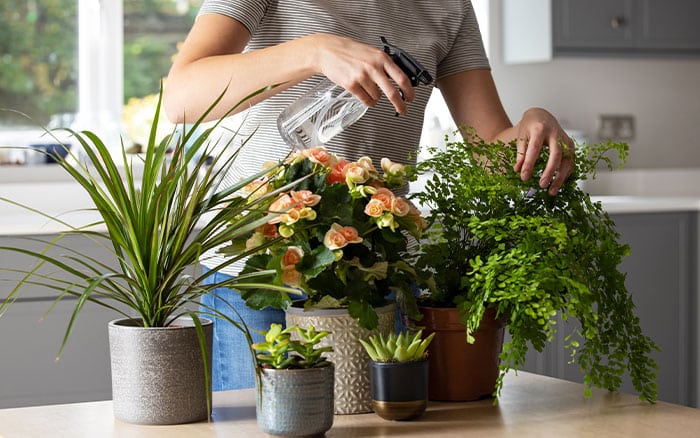Now that winter has arrived you may think that whacking up the heat in the house will help your houseplants, but think again… A lot of houseplants come from hot, humid jungle regions and really suffer in the dry environment we create when heating our homes. So, here’s how to increase humidity for houseplants…
A dry atmosphere can also attract pests such as red spider mite who thrive in hot, dry conditions. Increasing the room’s humidity will not only help drive these horrors away but also keep your plants looking healthy and happy and there are a few easy ways to achieve this.
First things first, if you know the names or still have the labels, check the country and region where each of your houseplants originate. This will give you an idea if they need a dry or high humidity environment.
Huddle your houseplants
Place houseplants together in high and low humidity loving groups.
Generally, houseplants with obviously hairy leaves such as Streptocarpus and African violets don’t need high humidity and should be kept separately from humidity lovers such as Adiantum (maidenhair ferns) and Maranta leuconeura (prayer plants).

Placing a water filled saucer in the middle of high humidity loving plant groups will help create a mini high-humid microclimate amongst them.
How to tell if your plants need extra humidity

There are several signs that your plants are struggling. Have a look at the leaf edges and check if they are becoming brown, crispy, and starting to turn yellow. Is the plant starting to droop and lose its healthy shine?
If you’re easily able to, take the plant out of its pot and check it doesn’t have a soil pest such as wine weevil grubs eating the roots. If there are no sign of pests then it’s likely the plants need a higher humidity level.
Misting
If you don’t already own one, invest in a bottle with a spray nozzle, keep it filled with rain or distilled water and regularly spray the leaves of your plants that need high humidity.
It’s only a temporary help, as the heat in your house continuously pulls the moisture out of the air, but you can use this in conjunction with other remedies.

Avoid draughts and hot spots

Don’t place your plants near doorways or corridors because draughts will lower humidity.
If you have underfloor heating put the plants on a table and if you have radiator heated rooms keep the plants well away from the radiators, this is because it’s where the room’s humidity is likely to be at its lowest.
Humid rooms
Some rooms in the house naturally create more humidity. Bathrooms, utility rooms and kitchens all have the potential to generate humidity and so think about putting a few of your humidity loving houseplants in these areas.
Bath-time
Take your humidity loving plants into the bathroom with you when you shower or bath, so they have access to some extra moisture and humidity.

Pebble trays
This is a simple tip I use when going on holiday. Fill a couple of trays with a single layer of pebbles and add water so that the pebbles are 75% covered with water and the top 25% clear of water. Then place your houseplants close together on top of the pebbles.
As the room heats up, the tray water evaporates and is released into the air up and around the plants. Ensure you keep topping up the water and never let it totally cover the pebbles as this may cause the plants’ roots to rot.
Buy a humidifier
These are generally reasonably inexpensive plug in electrical devices that push steam or water vapour into the air. This in effect acts a natural moisturising agent for both humans and humidity loving plants and could well be the long-term answer to keeping your plants hydrated and happy.

Leave A Comment